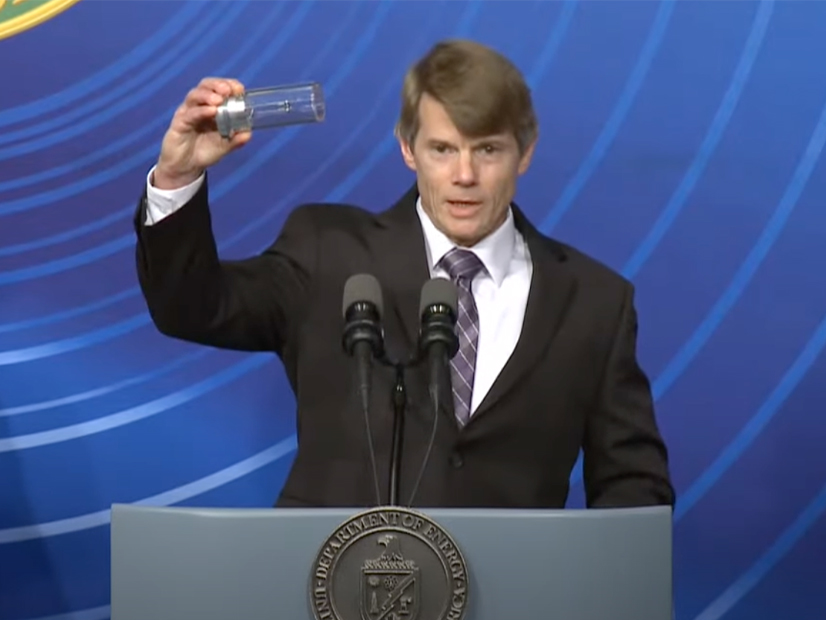
The results of more than 60 years of effort at a federal laboratory charged with ensuring the reliability of U.S. thermonuclear weapons could give the nation the ultimate weapon to fight climate change with a technology capable of producing carbon- and radiation-free energy.
White House and defense policymakers joined Energy Secretary Jennifer Granholm on Tuesday and a research team from Lawrence Livermore National Laboratory to provide a few details of the technology that researchers developed to pull off a global first: less than one second of controlled hydrogen fusion that created more energy than had been required to initiate it. (See related story, DOE to Announce Major Advance in Fusion Technology.)
That’s the same kind of reaction that powers stars, including the sun. And it’s the same physics at the heart of a hydrogen bomb.
“We got out 3.15 megajoules. We put in 2.05 megajoules in the laser,” explained Marvin Adams, Texas A&M nuclear engineering professor and deputy administrator for defense programs at the Department of Energy. “That’s never been done before in any fusion laboratory anywhere,” he said in a detailed panel discussion that followed the official announcement.
The experiment involved focusing the light of powerful lasers on a tiny capsule suspended inside a glass cylinder. The capsule, about the size of a peppercorn or half a BB, contained isotopes of hydrogen. The force of the lasers, which had been converted to X-rays, compressed the hydrogen isotopes to the point at which they merged, releasing the energy in the form of heat.
The entire experiment — energizing 192 of the most powerful lasers on the planet — required more than 300 megajoules, said Adams.
That meant that powering up the lasers took a little over 83 kWh of electricity — not exactly an energy hog, but still far more power than produced in the small capsule in which the fusion occurred. In 2021, the average monthly residential power consumption was 886 kWh, according to Energy Information Administration.
“The laser wasn’t designed to be efficient,” Adams quickly added. “The laser was designed to give us as much juice as possible to make this incredible condition possible in the laboratory. There are many, many steps that would have to be made in order to get to inertial fusion as an energy source.”
Granholm noted that the Biden administration’s goal is to develop a commercial fusion reactor within 10 years. “This demonstrates that it can be done,” she said. “That threshold being crossed allows [researchers] to start working on better lasers, more efficient lasers, on better containment capsules — the things that are necessary to allow it to be modularized and taken to commercial scale.”
The strategy at LLNL has been based on using the powerful lasers not only to jumpstart fusion but also to control the reaction after it has begun with the pressure of the beams themselves.
The resulting “inertial confinement fusion” not only relies on the pressure of the laser beams to force hydrogen isotopes close enough together to initiate the fusion but also to confine the resulting explosive results in order to create conditions for a controlled but continuous fusion.
The fusion produces enormous amounts of heat that could be used to produce steam to power turbines and generators just as commercial fission reactors operate today.
There are several private research and development companies that are working to develop fusion reactions controlled by extremely powerful magnets rather than the force of lasers. California-based TAE Technologies has developed fusion experiments creating and magnetically controlling 135 million-degree plasma. (See TAE: Fusion Reactor Controls 135M-degree Plasma.)
TAE’s goal is to build the hardware and a process to produce 180 million-degree plasma, the point at which fusion can continue, again controlled by ultra-powerful magnetic fields.
General Fusion, a Canadian company, earlier this week announced it had achieved a milestone: controlling the superheated plasma with compression alone for brief periods rather than with magnetic fields or lasers.
LLNL Director Kim Budil said the competing technologies will “feed off each other” in the future. “Many technologies will grow out of both fields in addition to the path to a fusion power plant. I think having both [technologies] is important.
“If we could not ignite capsules in the laboratory, you could not see a pathway to an inertial confinement fusion energy plant,” she said. “So this was a necessary first step.” She noted that the laser array at the lab “was built on 1980s laser technology.”
“We need to bring modern technology approaches to the drivers. We need to think about all the system questions.”

